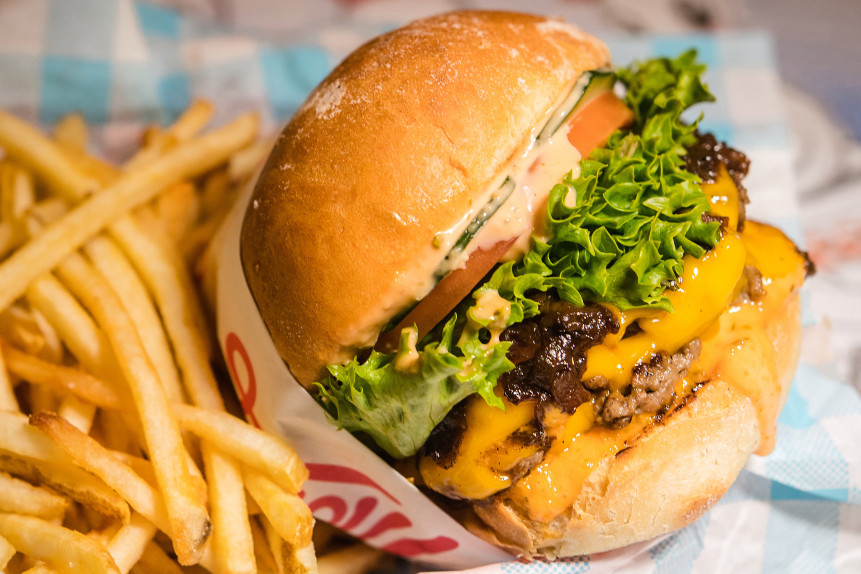
Plant-based burgers Impossible and Beyond get an upgrade and more recognition
There are plenty of new gadgets coming to market, from 8K televisions or Alexa-equipped toilets. But publisher Digital Trend’s pick for top tech winner at this month’s Consumer Electronics Show in Las Vegas wasn’t a gadget at all. It was the Impossible Burger 2.0.
The new, improved versions of the plant-based patty and its main competitor, the Beyond Burger, are rolling out in restaurants ranging from hipster hangouts to huge fast food chains as they strive to give diners alternatives to eating meat. “They feel almost like they’re doing a good deed,” Nic Adler of Monty’s Good Burger, one of the first restaurants to get 2.0, said about the customers in a recent telephone interview.
The trade show honor shows how far the latest generation of meat substitutes has come in just a couple of years, and how rapidly these products are moving toward the mainstream.
The Impossible Burger was introduced by Redwood City-based Impossible Foods in July 2016. Created with plant-based ingredients and genetic engineering, it was intended to have the look, texture, and cooking qualities of real beef — and the same consumers, flexitarians who for health or ethical reasons want to cut back on beef consumption. Original ingredients included wheat and potato proteins, but with 2.0 the company uses soy.
Its first major upgrade improves on the taste, cuts fat, and eliminates gluten, according to the company. Unlike the original Impossible burger, which was intended for flat-top cooking, the 2.0 can be prepared in a number of ways.
It’s huge that you can throw one the Impossible patty on a grill and it will hold together instead of falling through the slats, said Adler.
He is a concert producer and investor in Monty’s Good Burger, which has an entirely vegan menu at its two locations in Los Angeles and Riverside.
The Impossible Burger’s main competitor is Los Angeles-based Beyond Meat. It also announced a 2.0 version of its Beyond Burger just before the electronics trade show.
It describes the Beyond Burger 2.0 as having a meatier taste and texture than its original, also launched in 2016, as well as being a more complete protein source, delivering nine essential amino acids. It gets its protein from peas, brown rice and mung beans and includes beet juice that replicates the juiciness of a meat-based burger.
Gateway burgers
Beyond Meat launched 2.0 with a partnership with Carl’s Jr., which is now serving a Beyond version of its signature Famous Star cheeseburger and will substitute Beyond patties in any burger or sandwich for a $2 upcharge.
Impossible Foods planned a slower rollout of the Impossible Burger 2.0, starting with a partnership with celebrity chefs Mary Sue Milliken and Susan Feniger and their Border Grill in the Mandalay Bay Resort & Casino on the Las Vegas Strip.
But on Jan. 15, two days after CES, the company announced it had accelerated its launch due to demand after CES. It is now available in 200 restaurants nationwide, with placement in grocery stores to come.
In Southern California, Umami Burger, Hopdoddy, The Counter and Monty’s are serving it.
Monty’s didn’t publicize 2.0, but on Jan. 15, customers with umbrellas were lined up out the door at its Koreatown location, Adler said. He called consumers of Impossible and Beyond burgers very plugged-in.
The buzz is having an impact.
“I’ve been doing research with … meat substitutes for decades, and I didn’t get as much attention as now,” said Joan Sabate of the Loma Linda University School of Public Health. “There’s definitely much talk about these products.
He is executive director of its Center for Nutrition, Lifestyle & Disease Prevention and has done several clinical trials on the health effects of eating nuts and other plant foods.
Although veggie burgers are nothing new, Sabate sees a few differences in the latest plant-based burger products from earlier brands such as Boca Foods Company, Morningstar Farms, and Cedar Lake Foods.
Earlier meat substitutes were made for home consumption and sold in cans or grocery store freezer sections. Beyond and Impossible burgers are aimed at restaurants, and in grocery stores, they’re intended for meat sections.
“If you are convinced that meat is not essential, then why even eat meat substitutes? You can have a perfect diet meatless, without eating a burger. You can have a hundred other things,” he said.
“The market is for those who want to stop eating meat or for those who want to continue eating something that tastes like meat.”
Growing market
That’s fine with Adler, who called Monty’s a “place of transition” to help people prefer plant-based meals and plant-based burgers.
“Our goal is to go after the person who has never tried a plant-based burger … I don’t care if people go to Monty’s for lunch and hit In-N-Out for dinner.”
When people transition from eating beef, it is often for health or ethical reasons, said Sabate. They are avoiding cholesterol and saturated fat in their diets; don’t approve of animals being raised for meat; or seek global sustainability.
“Eating meat in the last few years has been shown to be not as healthy as people thought …,” he said. “It also has a tremendous environmental impact. It increases greenhouse gas emissions. The residues of industrial meat production pollutes the waters and it pollutes the soil.
“Now there is, especially among younger generations, the idea that massive consumption of meat has to be reduced.”
Sabate said the U.S. population of vegetarians is holding steady at 5-8 percent, and the vegan population has grown from 1 to 2 percent.
“That sounds insignificant, but 2 percent of the American population means a few million more people buying these products that we’re discussing or other plant foods. It’s a growing market, but compared with the whole market it has a minority position.”
The Beyond Burger is easier to find. It’s in 25,000 U.S. outlets versus Impossible Burger’s 5,000. And they cost more than beef. Lunch at Monty’s Good Burger can cost $20 or more.
Adler acknowledges the Impossible Burger is expensive but said that he thinks that with more research and development Impossible Foods will bring down the price.
That’s why he thinks it’s appropriate for a meat substitute to be at an electronics trade show.
“It is technology … You don’t just do a 2.0. You do a 3.0 and a 4.0 and a 5.0.”
Editor’s note: This story has been updated to reflect the growth of Beyond Meats.

